Radiation astronomy/Theory
< Radiation astronomy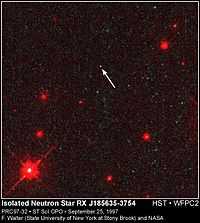
At its simplest theoretical radiation astronomy is the definition of terms to be applied to astronomical radiation phenomena. In essence, it is the theory of the science of biological, chemical, physical, and logical laws with respect to any natural radiation source in the sky especially at night.
While many of the first terms a student may encounter regarding natural radiation sources in the sky are at a secondary level, the term radiation, perhaps overly associated with the nuclear power, electricity-providing technology and associated mutations (usually fictional), is often reserved for the university undergraduate level and above.
Cautionary speculation is introduced to stimulate the imagination and perhaps open a few doors that may seem closed at present.
This learning resource is in part a lecture and in part an article.
Exploratory theory is the playtime activity that leads to discoveries which better our world. In the radiation physics laboratories here on Earth, the emission, reflection, transmission, absorption, and fluorescence of radiation is studied and laws relative to sources are proven.
The laboratories of radiation astronomy are limited to the radiation observatories themselves. To attempt to understand what is happening outside the observatory, it is necessary to explore the radiation itself within the laboratory. For theoretical radiation astronomy, this laboratory-based science is called astronomical radiation theory. It is the theory of the radiation as tested in the laboratory that explains at least in part the theory needed for radiation astronomy.
Notations
To indicate and designate certain relatively specific types of radiation, the Greek alphabet is used. For example, an alpha ray is designated:
Notation: let the Greek lower-case letter α indicate an alpha ray or alpha particle.
Capital Greek letters are often used for baryons.
Notation: let the Greek captial letter Λ indicate a lambda baryon.
English lower-case letters are used for particle forms of radiation which can be described by wave mechanics.
Notation: let the English lower-case letter n denote or indicate a neutron.
English capital letters (upper-case) are used for various types of radiation.
Notation: let the English upper-case (capital) letter X when juxtaposed to -ray indicate radiation at wavelengths longer than those of radiation that emanates from atomic nuclei to those just above the extreme ultraviolet; hence, X-ray, or X-radiation.
Notation: let the capital English letters XUV, or EUV, designate ultraviolet radiation between the far ultraviolet and soft, or ultrasoft, X-rays; specifically extreme ultraviolet.
Notation: let the English upper case letter N indicate a nucleon, or nucleon radiation. In nuclear reactions this letter may also indicate an isotope of the element nitrogen (chemical symbol N).
Notation: let the English upper case letter V indicate violet radiation.
Notation: let the English capital letter B indicate blue radiation.
With respect to subluminal radiation, the term ray (e.g., in cosmic ray) is a misnomer, as cosmic particles arrive individually, not in the form of a ray or beam of particles. However, when first discovered, cosmic rays are thought to be rays. Their subatomic particle nature is emphasized by writing cosmic ray particle.
Superluminal radiation does not appear to have any specific designation or notation, but there may be the following:
Notation: let the English capital letters CR indicate Cerenkov radiation.
In the literature when, say, tachyonic gamma rays are discussed, they are referred to as tachyonic γ rays.[1]
Additional notation is indicated when introduced.
Theory
The theory of radiation astronomy consists of four fundamental parts:
- the derivation of logical laws with respect to incoming radiation,
- the definitions of natural radiation sources,
- the definition of the sky and associated realms with respect to radiation, and
- the discovery, development, and calibration of radiation technology for astronomy.
In addition to the 'universals' of theoretical astronomy which are also applicable to theoretical radiation astronomy, there are specific notations, entities, objects and sources.
Def. "the electromagnetic radiation produced by the acceleration of a charged particle, such as an electron, when it is deflected by another charged particle, such as an atomic nucleus"[2] is called bremsstrahlung.
Def. "the electromagnetic radiation emitted by the accelerating charged particles in a synchrotron that are moving at near the speed of light"[3] is called synchrotron radiation.
Def. "light emitted by the Cerenkov effect"[4] is called Cerenkov radiation.
Def. "[a]ny of many mathematical relationships in which something is related to something else by an equation of the form f(x) = a.xk"[5] is called a power law.
Def. "ionizing radiation that is naturally present in the environment"[6] is called background radiation.
Principles
"A principle is a law or rule that has to be, or usually is to be followed, or can be desirably followed, or is an inevitable consequence of something, such as the laws observed in nature or the way that a system is constructed. The principles of such a system are understood by its users as the essential characteristics of the system, or reflecting system's designed purpose, and the effective operation or use of which would be impossible if any one of the principles was to be ignored.[7]"[8]
"Examples of principles:"[8]
- a descriptive comprehensive and fundamental law, doctrine, or assumption
- a normative rule or code of conduct,
- a law or fact of nature underlying the working of an artificial device.
Emissivity
Def. "a theoretical body, approximated by a hole in a hollow black sphere, that absorbs all incident electromagnetic radiation and reflects none"[9] is called a blackbody.
Def. "a body that radiates energy having a blackbody distribution reduced by a constant factor"[10] is called a graybody.
A white body has a "rough surface [that] reflects all incident rays completely and uniformly in all directions."[11]
"[T]he emissivity of a perfect white body equals 0."[12]
Def. "[t]he energy-emitting propensity of a surface, usually measured at a specific wavelength"[13] is called emissivity.
"The emissivity of a material (usually written ε or e) is the relative ability of its surface to emit energy by radiation. It is the ratio of energy radiated by a particular material to energy radiated by a black body at the same temperature. A true black body would have an ε = 1 while any real object would have ε < 1. Emissivity is a dimensionless quantity."[14]
"In general, the duller and blacker a material is, the closer its emissivity is to 1. The more reflective a material is, the lower its emissivity."[14]
Graybody assumption
Graybody assumption: "a surface's spectral emissivity and absorptivity do not depend on wavelength, so that the emissivity is a constant."[14]
Astrophysical graybody
"The monochromatic flux density radiated by a greybody at frequency  through solid angle
through solid angle  is given by"[14]
is given by"[14]

where  is the Planck function for a blackbody at temperature
is the Planck function for a blackbody at temperature  and emissivity
and emissivity  .
.
"For a uniform medium of optical depth  , radiative transfer means that the radiation will be reduced by a factor
, radiative transfer means that the radiation will be reduced by a factor  ."[14]
."[14]
"The optical depth is often approximated by the ratio of the emitting frequency to the frequency where  all raised to an exponent β."[14]
all raised to an exponent β."[14]
"For cold dust clouds in the interstellar medium β is approximately two. Therefore Q becomes,"[14]
 .
. 
 is the frequency where
is the frequency where 
Entities
Def.
"[t]hat which has a distinct existence as an individual unit", "[a]n existent something that has the properties of being real, and having a real existence", or "[t]he state or quality of being or existence"[15]
is called an entity.
Dominant groups
Notation: let the English capital letter Z stand for atomic number, as the number of protons in a chemical element's isotope atomic nucleus.
Notation: let various International System of Units, SI prefixes occur before electronvolt abbreviated as eV.
For example, PeV denotes 1015 eV.
"The most dominant group is the iron group (Z = 25 − 27), at energies around 70 PeV more than 50% of the all-particle [cosmic-ray] flux consists of these elements."[16]
"The X-ray luminosity of the dominant group [of galaxies] is an order of magnitude fainter than that of the X-ray jet."[17]
Neutron stars
A neutron star is a theoretical radiation source.
"[T]he huge number of neutrinos [a neutron star] emits carries away so much energy that the temperature falls within a few years [after formation] to around 106 kelvin.[18] Even at 1 million kelvin, most of the light generated by a neutron star is in X-rays. In visible light, neutron stars probably radiate approximately the same energy in all parts of visible spectrum, and therefore appear white."[19]
"[It] is a type of stellar remnant [(a compact star)] that can result from the gravitational collapse of a massive star during a Type II, Type Ib or Type Ic supernova event. Such stars are composed almost entirely of neutrons".[19]
Neutron stars are theorized as the radiation source for anomalous X-ray pulsars (AXPs), binary pulsars, high-mass X-ray binaries, intermediate-mass X-ray binaries, low-mass X-ray binaries (LMXB), pulsars, and soft gamma-ray repeaters (SGRs).
Relativistic jets
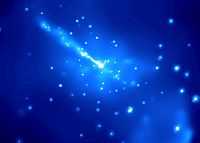
Def. "[a] collimated stream, spurt or flow of liquid or gas [or plasma in a narrow cone of particles]"[20] is called a jet.
Def. "at, or near the speed of light"[21] is called relativistic.
"The structure of relativistic jets in [active galactic nuclei] AGN on scales of light days reveals how energy propagates through jets, a process that is fundamental to galaxy evolution."[22]
"Their lengths can reach several thousand[23] or even hundreds of thousands of light years.[24] The hypothesis is that the twisting of magnetic fields in the accretion disk collimates the outflow along the rotation axis of the central object, so that when conditions are suitable, a jet will emerge from each face of the accretion disk. If the jet is oriented along the line of sight to Earth, relativistic beaming will change its apparent brightness. The mechanics behind both the creation of the jets[25][26] and the composition of the jets[27] are still a matter of much debate in the scientific community; it is hypothesized that the jets are composed of an electrically neutral mixture of electrons, positrons, and protons in some proportion."[28]
A relativistic jet emitted from the AGN of M87 is traveling at speeds between four and six times the speed of light.[23]
"The term 'superluminal motion' is something of a misnomer. While it accurately describes the speeds measured, scientists still believe the actual speed falls just below the speed of light."[23]
"It's an illusion created by the finite speed of light and rapid motion".[23]
"Our present understanding is that this 'superluminal motion' occurs when these clouds move towards Earth at speeds very close to that of light, in this case, more than 98 percent of the speed of light. At these speeds the clouds nearly keep pace with the light they emit as they move towards Earth, so when the light finally reaches us, the motion appears much more rapid than the speed of light. Since the moving clouds travel slightly slower than the speed of light, they do not actually violate Einstein's theory of relativity which sets light as the speed limit."[23]
Meteors

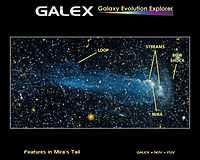

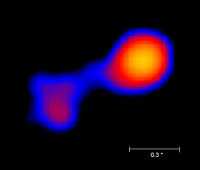
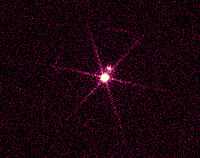
Particles come in a range of sizes and shapes together with associated phenomena.
At left is a radiated object and its associated phenomena.
"Ultra-violet studies of Mira by NASA's Galaxy Evolution Explorer (Galex) space telescope have revealed that it sheds a trail of material from the outer envelope, leaving a tail 13 light-years in length, formed over tens of thousands of years.[29][30] It is thought that a hot bow-wave of compressed plasma/gas is the cause of the tail; the bow-wave is a result of the interaction of the stellar wind from Mira A with gas in interstellar space, through which Mira is moving at an extremely high speed of 130 kilometres/second (291,000 miles per hour).[31][32] The tail consists of material stripped from the head of the bow-wave, which is also visible in ultra-violet observations. Mira's bow-shock will eventually evolve into a planetary nebula, the form of which will be considerably affected by the motion through the interstellar medium (ISM).[33]"ref name=Mira>"Mira, In: Wikipedia". San Francisco, California: Wikimedia Foundation, Inc. December 20, 2012. Retrieved 2012-12-21.</ref>
The term meteor is usually associated with visual radiation from an object streaking across an Earth sky at night.
In theoretical radiation astronomy, the size of the object and interpretation of associated phenomena are open to theory.
In the image at right, "Mira is moving from left to right. It is visible as the pinkish dot in the bulb shape at right. The yellow dot below is a foreground star. Mira is traveling so fast that it's creating a bow shock, or build-up of gas, in front of it, as can be seen here at right."[34]
"Like a boat traveling through water, a bow shock forms ahead of the star in the direction of its motion. Gas in the bow shock is heated and then mixes with the cool hydrogen gas in the wind that is blowing off Mira. This heated hydrogen gas then flows around behind the star, forming a wake."[34]
"Why is the wake of material glowing? When the hydrogen gas is heated, it transitions into a higher-energy state, which then loses energy by emitting ultraviolet light -- a process called fluorescence. The Galaxy Evolution Explorer has special instruments that can detect this ultraviolet light."[34]
"A similar fluorescence process is responsible for the Northern Lights -- a glowing, green aurora that can be seen from northern latitudes. However, in that case nitrogen and oxygen gas are fluorescing with visible light."[34]
"Streams and a loop of material can also be seen coming off Mira. Astronomers are still investigating what these streams are, but they suspect that they are denser parts of Mira's wind perhaps flowing out of the star's poles."[34]
"This image consists of data captured by both the far- and near-ultraviolet detectors on the Galaxy Evolution Explorer between November 18 and December 15, 2006. It has a total exposure time of about 3 hours."[34]
The stars in this false-color picture at lower left are separated by an angular size of only 0.6 arcseconds (equal to 70 times the distance between Earth and the Sun), but clearly resolved by the European Space Agency's Faint Object Camera (FOC). Image reconstruction techniques have been used to further enhance the details in the Mira images.
At lowest right is the only available X-ray image, by the Chandra X-ray Observatory, of Mira A on the right and Mira B (left). "Mira A is losing gas rapidly from its upper atmosphere [apparently] via a stellar wind. [Mira B is asserted to be a white dwarf. In theory] Mira B exerts a gravitational tug that creates a gaseous bridge between the two stars. Gas from the wind and bridge accumulates in an accretion disk around Mira B and collisions between rapidly moving particles in the disk produce X-rays."[35]
Some "data suggest that Mira B is a normal main sequence star of spectral type K and roughly 0.7 solar masses, rather than a white dwarf as first envisioned.[36]"[37]
Analysis in 2010 "of rapid optical brightness variations has indicated that Mira B is in fact a white dwarf.[38]"[37]
As a comparison, shown at left is an X-ray image of Sirius B and Sirius A. The bright source is Sirius B, a white dwarf star that has a surface temperature of about 25,000 degrees Celsius which produces very low energy X-rays. The surface effective temperature of Sirius A (spectral type A1V) is only 9,940±210 K,[39] while that of Sirius B (a white dwarf, DA2) is 25,200 K.[40] On the surface temperature of the photosphere alone, Sirius B would be a Class B star. Sirius A, according to SIMBAD is a known X-ray source.
Mira A, spectral type M7 IIIe[41], has an effective surface temperature of 2918–3192[42]. Mira A is not a known X-ray source according to SIMBAD, but here is shown to be one.
For Mira B, "the Lyman α region and FUV continuum out to 2600 Å is best fit by a white dwarf with a surface temperature of 9000 K. Using the new Hipparcos distance to Mira AB (128 pc), our estimate of the observed FUV luminosity agrees with the bolometric luminosity of a 9000 K white dwarf."[43]
Mira B and Sirius A are very similar on the basis of surface temperature. But, based on increasing surface temperature, the order is Mira A, Mira B, Sirius A, and Sirius B.
"The stellar limb of a red giant [such as Mira A] is not sharply-defined, as depicted in many illustrations. Instead, due to the very low mass density of the envelope, such stars lack a well-defined photosphere. The body of the star gradually transitions into a 'corona' with increasing radii.[44][45]"[46]
"A megacryometeor is a very large chunk of ice which, despite sharing many textural, hydro-chemical and isotopic features detected in large hailstones, is formed under unusual atmospheric conditions which clearly differ from those of the cumulonimbus cloud scenario (i.e. clear-sky conditions). They are sometimes called huge hailstones, but do not need to form in thunderstorms. Jesus Martinez-Frias, a planetary geologist at the Center for Astrobiology in Madrid, pioneered research into megacryometeors in January 2000 after ice chunks weighing up to 6.6 pounds (3.0 kg) rained on Spain out of cloudless skies for ten days."[47]
Like other rocky-object meteors, megacryometeors may originate from comets.
Planetary astronomy
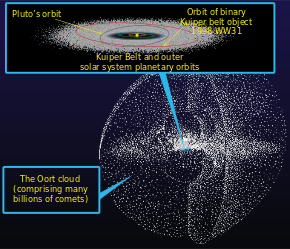
"The Oort cloud ... or the Öpik–Oort cloud[48] ... is a hypothesized spherical cloud of comets which may lie roughly 50,000 AU, or nearly a light-year, from the Sun.[49] This places the cloud at nearly a quarter of the distance to Proxima Centauri, the nearest star to the Sun. ... The outer limit of the Oort cloud defines the cosmographical boundary of the Solar System and the region of the Sun's gravitational dominance.[50]"[51]
Particle radiation

"Particle radiation has three main origins: (1) galactic cosmic radiation, (2) solar particle radiation, and (3) geomagnetically trapped particle radiation."[52]
Notation: let the phrase "high atomic number elements" be abbreviated to HZE.
"Space radiation may be classified according to origin as: (i) galactic cosmic radiation (87% protons, 12% alfa, 1% HZE), with energies between 1 and 103 GeV; (ii) solar particle radiation, consisting of charged particles in large clouds, mainly protons with an energy of about 1 GeV; (iii) geomagnetically trapped particle radiation, generated from the interaction of the radiation with the geomagnetic field comprising electrons with energies up to 7 MeV, protons with energies up to 600 MeV, and low energy heavy ions."[53]
Cosmic rays
In cosmic-ray astronomy, "[m]easurements from the spacecraft revealed a steady rise since May in collisions with high energy particles (above 70 MeV), which are believed to be cosmic rays emanating from supernova explosions far beyond the Solar System, with a sharp increase in these collisions in late August. At the same time, in late August, there was a dramatic drop in collisions with low-energy particles, which are thought to originate from the Sun.[54]"[55]
Neutrons
Around EeV (1018 eV) energies of ultra high energy neutron astronomy there may be associated ultra high energy neutrons “observed in anisotropic clustering ... because of the relativistic neutrons boosted lifetime.”[56] “[A]t En = 1020 eV, [these neutrons] are flying a Mpc, with their directional arrival (or late decayed proton arrival) ... more on-line toward the source.”[56] Although “neutron (and anti-neutron) life-lengths (while being marginal or meaningless at tens of Mpcs, the growth of their half-lives with energy may naturally explain an associated, showering neutrino halo.”[56]
Protons
The Sun, the coronal cloud around it, and the solar wind, which originates through the polar coronal holes apparently from the photosphere, are major sources of protons within the solar system.
Electrons
"The power into the Crab Nebula is apparently supplied by an outflow [wind] of ~1038 erg/s from the pulsar"[57] where there are "electrons (and positrons) in such a wind"[57]. These beta particles coming out of the pulsar are moving very close to light speed.
Positrons
“Two scenarios for the Galactic distribution of 511 keV line emission that remain viable after more than 4 years of observations with SPI [are]
- bulge + thick disk (BD) and
- halo + thin disk (HD).”[58]
Neutrinos
Some neutrinos originating from the Sun may be produced by the particle accelerator-type reactions occurring in and above the chromosphere. Differentiating these coronal cloud-induced neutrinos from the neutrino background and those theorized to be produced within the core of the Sun may someday be possible with neutrino astronomy.
Electromagnetics
Def. an action or process of throwing or sending out a traveling ray in a line, beam, or stream of small cross section is called radiation.
The term radiation is often used to refer to the ray itself.
"The speed of light in vacuum, [usually] denoted [by] c, is a ... physical constant important in many areas of physics. Its value is 299,792,458 metres per second, a figure that is exact [since] the length of the metre is defined from this constant and the international standard for time.[59]"[60] "[T]he most accurate standard for the metre is conveniently defined so that there are exactly 299,792,458 of them to the distance travelled by light in a standard second, giving a value for the metre that very accurately matches the now inadequately precise standard metre rule in Paris."[59]
"According to special relativity, c is the maximum speed at which all energy, matter, and information in the universe can travel. It is the speed of all massless particles and associated fields—including electromagnetic radiation such as light—in vacuum ... [The most accurate value is] 299792.4562±0.0011 [km/s].[61]"[60]
"Vacuum is space that is empty of matter. ... An approximation to such vacuum is a region with a gaseous pressure much less than atmospheric pressure.[62] Physicists often discuss ideal test results that would occur in a perfect vacuum, which they sometimes simply call "vacuum" or free space, and use the term partial vacuum to refer to an actual imperfect vacuum as one might have in a laboratory or in space."[63]
"In classical electromagnetism, the vacuum of free space, or sometimes just free space or perfect vacuum, is a standard reference medium for electromagnetic effects.[64][65] Some authors refer to this reference medium as classical vacuum, a terminology intended to separate this concept from QED vacuum or QCD vacuum where vacuum fluctuations can produce transient virtual particle densities and a relative permittivity and relative permeability that are not identically unity.[66]"[63]
"QED vacuum is a state with no matter particles (hence the name), and also no photons, no gravitons, etc. As described above, this state is impossible to achieve experimentally. (Even if every matter particle could somehow be removed from a volume, it would be impossible to eliminate all the blackbody photons.)"[63]
It could be stated that space is only a manifestation of the ubiquity of electromagnetic radiation. Space may be the result of that manifestation rather than a container in which electromagnetic radiation radiates. Electromagnetic radiation reradiates upon itself when pockets of concentration seek to reduce the concentration.
"[T]he vacuum permeability μ0 and permittivity ε0 may originate from the magnetization and the polarization of continuously appearing and disappearing fermion pairs."[67]
"[Modeling] the propagation of the photon in vacuum as a series of transient captures within these ephemeral pairs, [produces] a finite photon velocity. ... the propagation of a photon is a statistical process at scales much larger than the Planck scale. Therefore ... its time of flight [is likely] to fluctuate"[67] rather than remain a constant.
"[T]he impedance of a vacuum ... itself depends only on the electric charge of the particles in the vacuum, and not their masses."[68]
"[T]he properties of light propagation, culminating in a sum over all types of elementary particles existing in Nature [are] weighted only by their squared charges".[69]
Sources
Def. a natural source usually of radiation in the sky especially at night is called an astronomical source.
Def. a theory of the science of the biological, chemical, physical, and logical laws (or principles) with respect to any natural radiation source in the sky especially at night is called theoretical radiation astronomy.
Def. a cloud, or cloud-like, natural astronomical entity, composed of plasmas at least hot enough to emit X-rays is called a coronal cloud.
"An electron beam furnace (EB furnace) is a type of vacuum furnace employing [a] high-energy electron beam in vacuum as the mean for delivery of heat to the material being melted."[70]
As of December 5, 2011, "Voyager 1 is about ... 18 billion kilometers ... from the [S]un [but] the direction of the magnetic field lines has not changed, indicating Voyager is still within the heliosphere ... the outward speed of the solar wind had diminished to zero in April 2010 ... inward pressure from interstellar space is compacting [the magnetic field] ... Voyager has detected a 100-fold increase in the intensity of high-energy electrons from elsewhere in the galaxy diffusing into our solar system from outside ... [while] the [solar] wind even blows back at us."[71]
The source of heat that brings the coronal cloud near the Sun hot enough to emit X-rays may be an electron beam heating effect due to "high-energy electrons from elsewhere in the galaxy diffusing into our solar system from outside"[71].
Radiation astronomy
Radiation astronomy is astronomy applied to the various extraterrestrial sources of radiation, especially at night. It is also conducted above the Earth's atmosphere and at locations away from the Earth, by satellites and space probes, as a part of explorational (or exploratory) radiation astronomy.
Radiation is all around us on top of the Earth's crust, regolith, and soil, where we live. The laboratories of radiation astronomy are limited to the radiation observatories themselves and the computers and other instruments (sometimes off site) used to analyse the results.
Radioactivity emissions

Def. a spontaneous emission of an α ray, β ray, or γ ray by the disintegration of an atomic nucleus is called radioactivity.[72]
"Radioactive decay is a stochastic (i.e., random) process at the level of single atoms, in that, according to quantum theory, it is impossible to predict when a particular atom will decay.[73] However, the chance that a given atom will decay is constant over time. For a large number of atoms, the decay rate for the collection is computable from the measured decay constants of the nuclides (or equivalently from the half-lifes)."[74]
"Radioactive primordial nuclides found in the Earth are [probably] residues from ancient supernova explosions which occurred before the formation of the solar system. They [may be] the long-lived fraction of radionuclides surviving in the primordial solar nebula through planet accretion until the present. The naturally occurring short-lived radiogenic radionuclides found in rocks [may be] the daughters of these [radioactive] primordial nuclides. Another minor source of naturally occurring radioactive nuclides are cosmogenic nuclides, formed by cosmic ray bombardment of material in the Earth's atmosphere or crust. ... Radionuclides can also be produced artificially e.g. using particle accelerators or nuclear reactors."[74]
"Although the Earth's field is generally well approximated by a magnetic dipole with its axis near the rotational axis, there are occasional dramatic events where the North and South geomagnetic poles trade places. These events are called geomagnetic reversals. Evidence for these events can be found worldwide in basalts, sediment cores taken from the ocean floors, and seafloor magnetic anomalies. Reversals occur at apparently random intervals ranging from less than 0.1 million years to as much as 50 million years. The most recent such event, called the Brunhes–Matuyama reversal, occurred about 780,000 years ago.[75][76]"[77]
The longer the period of geomagnetic reversal the longer the Earth's surface rocks receive a heightened exposure to solar and galactic cosmic rays that in turn may make these rocks appear older than they are.
Backgrounds
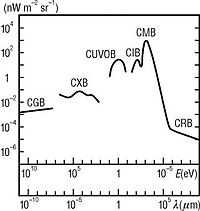
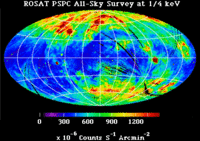
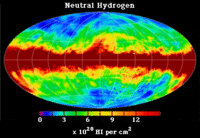
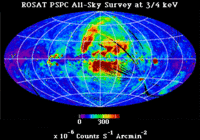
The diffuse infrared background has been surveyed by the Diffuse Infrared Background Experiment (DIRBE) aboard NASA's Cosmic Background Explorer (COBE).[78] "The DIRBE instrument was an absolute radiometer with an off-axis folded-Gregorian reflecting telescope, with 19 cm diameter aperture.[78]"[79] "[B]rightness maps of the universe at ten frequency bands ranging from the near to far infrared (1.25 to 240 micrometer) [have been obtained].[78] Also, linear polarization was measured at 1.25, 2.2, and 3.5 micrometers.[78] During the mission, the instrument could sample half the celestial sphere each day.[78]"[79]
"DIRBE also detected 10 new far-IR emitting galaxies in the region not surveyed by IRAS as well as nine other candidates in the weak far-IR that may be spiral galaxies. Galaxies that were detected at the 140 and 240 μm were also able to provide information on very cold dust (VCD). At these wavelengths, the mass and temperature of VCD can be derived."[80]
"When these data were joined with 60 and 100 μm data taken from IRAS, it was found that the far-infrared luminosity arises from cold (≈17–22 K) dust associated with diffuse HI cirrus clouds, 15-30% from cold (≈19 K) dust associated with molecular gas, and less than 10% from warm (≈29 K) dust in the extended low-density HII regions.[81]"[80]
"The diffuse extragalactic background radiation (DEBRA) refers to the diffuse photon field from extragalactic origin that fill our Universe. It contains photons over ∼ 20 decades of energy from ~10−7 eV to ~100 GeV. The origin and the physical processes involved are different within every wavelength range. There are plenty of observational evidences that support the existence of the DEBRA.[82]"[83]
The figure at right "shows a schematic picture, based on many different data sets, of the spectral intensity (also called spectral radiance) multiplied by wavelength of the DEBRA over all the electromagnetic spectrum. This representation is convenient because the area inside the curve is the energy. The nature and history of the universe is coded in this radiation field and any realistic cosmological model must be able to describe it. Understanding the DEBRA is a major challenge of modern cosmology with huge consequences in other fields of astrophysics, therefore extraordinary efforts are being put by theoreticians, observers, and instrumentalists to do so."[83]
"The diffuse extragalactic background light (EBL) is all the accumulated radiation in the Universe due to star formation processes, plus a contribution from active galactic nuclei (AGNs). This radiation covers the wavelength range between ~ 0.1-1000 microns (these are the ultraviolet, optical, and infrared regions of the electromagnetic spectrum). The EBL is part of the diffuse extragalactic background radiation (DEBRA), which by definition covers the overall electromagnetic spectrum. After the cosmic microwave background, the EBL produces the second-most energetic diffuse background, thus being essential for understanding the full energy balance of the universe."[84]
"The understanding of the EBL is also fundamental for extragalactic very-high-energy (VHE, 30 GeV-30 TeV) astronomy.[85] VHE photons coming from cosmological distances are attenuated by pair production with EBL photons. This interaction is dependent on the spectral energy distribution of the EBL. Therefore, it is necessary to know the SED of the EBL in order to study intrinsic properties of the emission in the VHE sources."[84]
"There are empirical approaches that predict the overall SED of the EBL in the local Universe as well as its evolution over time. These types of modeling can be divided in four different categories according to.[86]"[84]
(i) Forward evolution, which begins with cosmological initial conditions and follows a forward evolution with time by means of semi-analytical models of galaxy formation.[87][88][89]
(ii) Backward evolution, which begins with existing galaxy populations and extrapolates them backwards in time.[90][91][92]
(iii) Evolution of the galaxy populations that is inferred over a range of redshifts. The galaxy evolution is inferred here using some quantity derived from observations such as the star formation rate density of the universe.[93][94][95]
(iv) Evolution of the galaxy populations that is directly observed over the range of redshifts that contribute significantly to the EBL.[96]
"In addition to discrete sources which stand out against the sky, there is good evidence for a diffuse X-ray background.[97] During more than a decade of observations of X-ray emission from the Sun, evidence of the existence of an isotropic X-ray background flux was obtained in 1956.[98] This background flux is rather consistently observed over a wide range of energies.[97] The early high-energy end of the spectrum for this diffuse X-ray background was obtained by instruments on board Ranger 3 and Ranger 5.[97] The X-ray flux corresponds to a total energy density of about 5 x 10−4 eV/cm3.[97] The ROSAT soft X-ray diffuse background (SXRB) image shows the general increase in intensity from the Galactic plane to the poles. At the lowest energies, 0.1 - 0.3 keV, nearly all of the observed soft X-ray background (SXRB) is thermal emission from ~106 K plasma."[99]
"By comparing the soft X-ray background with the distribution of neutral hydrogen, it is generally agreed that within the Milky Way disk, super soft X-rays are absorbed by this neutral hydrogen."[99]
Gamma rays
"A number of observations by space-based telescopes have revealed ... gamma ray emissions ... terrestrial gamma-ray flashes (TGFs). These observations pose a challenge to current theories of lightning, especially with the discovery of the clear signatures of antimatter produced in lightning.[100]"[101]
"[A] TGF [has been linked] to an individual lightning stroke occurring within 1.5 ms of the TGF event,[102] proving for the first time that the TGF was of atmospheric origin and associated with lightning strikes"[101].
"[T]he Reuven Ramaty High Energy Solar Spectroscopic Imager (RHESSI) spacecraft, as reported by David Smith of UC Santa Cruz, has been observing TGFs at a much higher rate, indicating that these occur about 50 times per day globally (still a very small fraction of the total lightning on the planet). The energy levels recorded exceed 20 MeV. ... [Apparently, the] gamma radiation fountains upward from starting points at surprisingly low altitudes in thunderclouds. ... Steven Cummer, from Duke University's Pratt School of Engineering, said, "These are higher energy gamma rays than come from the sun. And yet here they are coming from the kind of terrestrial thunderstorm that we see here all the time." ... In 2009, [the] Fermi Gamma Ray Telescope in Earth orbit observed [an] intense burst of gamma rays corresponding to positron annihilations coming out of a storm formation. Scientists wouldn't have been surprised to see a few positrons accompanying any intense gamma ray burst, but the lightning flash detected by Fermi appeared to have produced about 100 trillion positrons. This has been reported by media in January 2011, it is an effect, never considered to happen before.[103]"[101]
X-rays
Def. "[a]ny of many mathematical relationships in which something is related to something else by an equation of the form f(x) = a.xk"[5] is called a power law.
In terms of radiation detected, for example, f(x) = photons (cm2-sec-keV)-1 versus keV. As the photon flux decreases with increasing keV, the exponent (k) is negative. Observations of X-rays have sometimes found the spectrum to have an upper portion with k ~ -2.3 and the lower portion being steeper with k ~ -4.7.[104] This suggests a two stage acceleration process.[104]
Opticals
"Already it has allowed ground-based telescopes to produce images with sharpness rivalling those from the Hubble Space Telescope. The technique is expected to revolutionize the future of ground-based optical astronomy."[105]
Ultraviolets
"The tail-like configuration of the emitted material appears to result from Mira's uncommonly high speed (about 130 km/s (81 mi/s)) relative to the Milky Way galaxy's ambient gas. Mira itself is seen as a small white dot inside a blue bulb."[106]
Visuals
"Color indices of distant objects are usually affected by interstellar extinction —i.e. they are redder than those of closer stars. The amount of reddening is characterized by color excess, defined as the difference between the Observed color index and the Normal color index (or Intrinsic color index), the hypothetical true color index of the star, unaffected by extinction. For example, ... we can write it for the B-V color:"[107]
Violets
As of 1977, "model calculations cannot reproduce the observed breadth of the Ca II λ3933 line in Da,F stars like Ross 627 without appealing to an unknown line-broadening mechanism".[108]
Blues
There is a blue haze layer near the south polar region of Titan. "The difference in color [blue above and orange nearer the surface] could be due to particle size of the haze. The blue haze likely consists of smaller particles than the orange haze."[109]
Since Neptune's atmospheric methane content is similar to that of Uranus, some unknown atmospheric constituent is thought to contribute to Neptune's colour.[110]"[111]
"[T]he [two] gaps [at colors corresponding to log Teff ~ 4.11 (gap 1) and log Teff ~ 4.33 (gap 2) in the distribution of high-latitude faint blue stars may be] a horizontal-branch phenomenon. ... [C]urrent theoretical concepts of the advanced evolution of Population II stars can explain the majority of blue halo stars.”[112]
Cyans
“[A]ll the blue basalt types (high in UV/VIS ratio [0.40/0.56 µm]) are also the darkest mare soils.”[113] Both Luna 24 and Apollo 12 soil samples are from mare soils that reflect primarily cyan that is likely due to the presence of TiO2 in the soils.[113]
"Previous work has suggested that a cyan color in the multispectral frame represents highland material, and that yellows and greens are freshly excavated basalts. However, we have recently found that a cyan color can also result from a freshly excavated high-Ti basalt."[114]
Greens

"A burst of color lit the shallow waters of the Gulf of Mexico off the Yucatan Peninsula on December 14, 2008, when the Moderate Resolution Imaging Spectroradiometer (MODIS) on NASA’s Terra satellite captured this image [at right]. The swirls of tan, green, blue, and white are most likely sediment in the water. The sediment scatters light, giving the water its color. The sediment comes from two sources: the land and the sea floor. Some of the color may also come from phytoplankton, tiny plant-like organisms that live in the sun-lit surface waters of the ocean."[115]
Are the Earth auroras due to chlorophyll-containing phytoplankton aloft in the upper atmosphere?
Yellows
Surveys of H II regions in spiral galaxies have suggested that N/O abundance ratios increase from outer-arm nebulae to inner-arm nebulae.[116]
Oranges
"Lithium depletion through atomic diffusion has been suggested as a solution to the discrepancy between the Spite plateau abundance and the predicted value of the primordial lithium abundance"[117].
Reds
"[T]he standard solar models have enjoyed tremendous success recently in terms of agreement between the predicted outer structure and the results from helioseismology[, but] some observed properties of the Sun still defy explanation, such as the degree of Li depletion" [the "solar Li abundance is roughly a factor of 200 below the meteoritic abundance"].[118]
Infrareds
"[S]pectral features [have been identified] in the near infrared I and K bands. These are ... characteristic of Wolf-Rayet stars: strong, broad emission lines of He I and He II, but no strong hydrogen lines. These observations strongly suggest the presence of a dense wind in the Cyg X-3 system, and may indicate that the companion is a fairly massive helium star"[119].
Submillimeters
"[F]or wavelengths between 0.35 and 0.45 mm ... the radiances can be matched by models which include NH3 ice particles which are between 30 and 100 µm in size, regardless of the scale height characterizing the cloud."[120]
Radios
"The radio observation of perhaps greatest human interest is the claim of interstellar glycine,[121] the simplest amino acid, but with considerable accompanying controversy.[122] One of the reasons why this detection [is] controversial is that although radio (and some other methods like rotational spectroscopy) are good for the identification of simple species with large dipole moments, they are less sensitive to more complex molecules, even something relatively small like amino acids.”[123]
Superluminals
"[C]harged particles moving faster than light through the vacuum emit Cherenkov radiation. How can a particle move faster than light? The weak speed of a charged particle can exceed the speed of light."[124]
Theoretical astronomy
Def. a theory of the science of the biological, chemical, physical, and logical laws (or principles) with respect to any natural being, body, thing, entity, or object in the sky especially at night is called theoretical astronomy.
Astrochemistry
Def. "the study of the abundance and reactions of chemical elements and molecules in the universe, and their interaction with radiation"[123] is called astrochemistry.
Def. "[t]he study of the chemical composition of stars and outer space"[125] is called astrochemistry.
"By comparing astronomical observations with laboratory measurements, astrochemists can infer the elemental abundances, chemical composition, and temperatures of stars and interstellar clouds. This is possible because ions, atoms, and molecules have characteristic spectra: that is, the absorption and emission of certain wavelengths (colors) of light, often not visible to the human eye. However, these measurements have limitations, with various types of radiation (radio, infrared, visible, ultraviolet etc.) able to detect only certain types of species, depending on the chemical properties of the molecules. Interstellar formaldehyde was the first polyatomic organic molecule detected in the interstellar medium. ... One of the most abundant interstellar molecules, and among the easiest to detect with radio waves (due to its strong electric dipole moment), is CO (carbon monoxide). In fact, CO is such a common interstellar molecule that it is used to map out molecular regions.[126]"[123]
"The radio observation of perhaps greatest human interest is the claim of interstellar glycine,[121] the simplest amino acid, but with considerable accompanying controversy.[122] One of the reasons why this detection was controversial is that although radio (and some other methods like rotational spectroscopy) are good for the identification of simple species with large dipole moments, they are less sensitive to more complex molecules, even something relatively small like amino acids."[123]
Regions
A stellar active region is "[a] localized, transient volume of [a stellar] atmosphere in which plages, [star]spots, faculae, flares, etc., may be observed. Active regions are the result of enhanced magnetic fields; they are bipolar and may be complex if the region contains two or more bipolar groups."[127]
Astrognosy
Generally, the performance of radiation astronomy yields facts about those portions of celestial objects such as the Sun or the Earth that are radiating at least in the direction of the telescopes and detectors where the observer is at.
Theoretical astrognosy as it pertains to radiation astronomy consists of speculation about internal structure that has some experimental support which may provide a mathematical model that describes the spectral, temporal, and spatial radiation distributions for some or all types of radiation local to the entity, source, or object.
Astrophysics
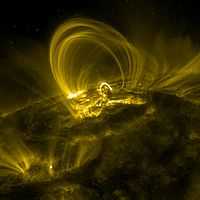
The image at right shows particle rays leaving the surface of the Sun (darker ends of the loops), traveling in a loop controlled by a local magnetic field similar to how particle accelerators accelerate, steer, and aim a stream of particles at a target (the much brighter regions in the chromosphere). The loops have a temperature of approximately 106 K and are emitting X-rays (synchrotron and cyclotron radiation).
"Coronal loops form the basic structure of the lower corona and transition region of the Sun. These highly structured and elegant loops are a direct consequence of the twisted solar magnetic flux within the solar body. The population of coronal loops can be directly linked with the solar cycle; it is for this reason coronal loops are often found with sunspots at their footpoints. The upwelling magnetic flux pushes through the photosphere, exposing the cooler plasma below."[128]
Loops of magnetic flux (closed flux tubes) well up from the solar body and fill with hot solar plasma.[129] Due to the heightened magnetic activity in these coronal loop regions, coronal loops can often be the precursor to solar flares and coronal mass ejections (CMEs).
"Ideal [ Magnetohydrodynamics (MHD)] instabilities [may be] driven by current ... gradients".[130]
A dynamo, such as a radiative dynamo, is a theoretical construction to explain the magnetohydrodynamic properties of plasma occurring in or just above astronomical objects including stars. As such it is a part of theoretical stellar science and theoretical astrophysics.
Astrography

"Fermi National Accelerator Laboratory (Fermilab), located just outside Batavia, Illinois, near Chicago, is a US Department of Energy national laboratory specializing in high-energy particle physics."[131]
"In addition to high energy collider physics, Fermilab is also host to a number of smaller fixed-target and neutrino experiments, such as MiniBooNE (Mini Booster Neutrino Experiment), SciBooNE (SciBar Booster Neutrino Experiment) and MINOS (Main Injector Neutrino Oscillation Search). The MiniBooNE detector is a 40-foot (12 m) diameter sphere which contains 800 tons of mineral oil lined with 1520 individual phototube detectors. An estimated 1 million neutrino events are recorded each year. SciBooNE is the newest neutrino experiment at Fermilab; it sits in the same neutrino beam as MiniBooNE but has fine-grained tracking capabilities. The MINOS experiment uses Fermilab's NuMI (Neutrinos at the Main Injector) beam, which is an intense beam of neutrinos that travels 455 miles (732 km) through the Earth to the Soudan Mine in Minnesota."[131]
Astrohistory


Theoretical astrohistory concerns speculations, models, and experimental facts with respect to what may have been going on in the past of the hominins of Earth. History is divided into ancient history, early history, archeoastronomy, historical astronomy, and history of astronomy. There are special topics such as classical planets, cosmogony, early telescopes, first astronomical sources, and radiation history.
Visual awareness of the sky may make the Moon one candidate for the first visual source and perhaps the first astronomical source.
A first astronomical X-ray source is usually considered to be the Sun.
“Uranus ... is named after the ancient Greek deity of the sky Uranus ..., the father of Cronus (Saturn) and grandfather of Zeus (Jupiter). Though it is visible to the naked eye like the five classical planets, it was never recognized as a planet by ancient observers because of its dimness and slow orbit.[132]”[133] The planet Uranus may be related to the early god Ouranos perhaps through observation using an air telescope with planoconvex lenses. Ouranos may be the sky or something in the sky that may have moved further away with time.
5102 b2k, -3102 or 3102 BC, is the historical year assigned to a Hindu table of planets that does not include the classical planet Venus.[134] "Vénus seule ne s'y trouvait pas."[134] "Venus alone is not found there."[135] "Babylonian astronomy, too, had a four-planet system. In ancient prayers the planets Saturn, Jupiter, Mars, and Mercury are invoked; the planet Venus is missing; and one speaks of "the four-planet system of the ancient astronomers of Babylonia."[136]"[135]
The image at right is a painting by artist Giorgio Vasari (1511–1574). Behind and above the main focus on Cronus (Saturn) castrating Uranus (the Greek sky god before Zeus) is what appears to be "some kind of Armillary sphere"[137]. Specifically, the "[w]hole thing is some kind of Armillary sphere"[137].
Even more than that is an object (an early telescope perhaps) angled slightly upward (right to left) that appears to be pointed at or above the large metallic ring. This object seems to be painted as if it extends through the top hole of the armillary sphere. At the upper left end of the object is an embellished end piece that may have a lens (objective lens) or piece of material the diameter of which matches that of the tube behind the embellishment. The midsection appears to taper to a smaller diameter near the right end. The right end has an even smaller piece attached or inserted that looks like an eyepiece lens holder. This tubular object seems to be receiving hands in the air praise from two people to its left. The armillary sphere may be tilted ~23 1/2°.
"Beginning with the daguerreotype of the corona of 1851, the Reverend Lecturer had thrown on the screen pictures illustrating the form of the corona in different years. The drawings of those of 1867, 1878, and 1900 all showed long equatorial extensions with openings at the solar poles filled with beautiful rays."[138] "Some of the theories of the solar corona were then illustrated and discussed."[138]
- "Prof. Schaeberle has proposed a mechanical origin of the solar corona, due to the forces of ejection of particles from the solar limb, as evidenced by the prominences, and the force of gravity under the particular conditions of the solar rotation and the inclination of its axis to the earth's orbit."[138]
- "The electrical theory of the corona does not negative the mechanical theory, but supplements it. In addition to the forces of gravity and ejection, it takes account of the repulsive force which the sun exerts on matter which has the same electrical sign as itself, and which has been ejected from it."[138]
- "it would seem that the solar corona is of the nature of an electrical aurora round the sun."[138]
- "the coronoidal discharges in poor vacua obtained by Prof. Pupin about an insulated metal ball are exceedingly like the rays and streamers of the solar corona."[138]
Cosmogony
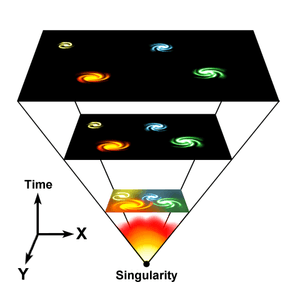
Cosmogony “is any scientific theory concerning the coming into existence, or origin, of the cosmos or universe, or about how what sentient beings perceive as "reality" came to be.”[139]
The Big Bang theory starts with a gravitational singularity, although the origins of that singularity remain an unsolved problem in physics. Although theories exist, testable theories are lacking (e.g. of quantum gravity), and there is also a need for more advanced particle accelerators.
"Chaos (Greek χάος, khaos) refers to the formless or void state preceding the creation of the universe or cosmos in the Greek creation myths, more specifically the initial "gap" created by the original separation of heaven and earth."[140]
"The Roman mythographer Hyginus, says Aether was the son of Chaos and Caligo (Darkness).[141]"[142]
"According to the poet Alcman, Aether was the father of Ouranos, the god of the sky. While Aether was the personification of the upper air, Ouranos was literally the sky itself, composed of a solid dome of brass.[143]"[142]
Source astronomy
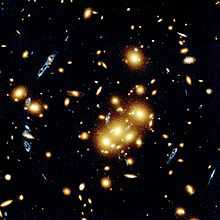
"This Hubble Space Telescope image [at right] shows several blue, loop-shaped objects that actually are multiple images of the same galaxy. They have been duplicated by the gravitational lens of the cluster of yellow, elliptical and spiral galaxies - called 0024+1654 - near the photograph's center. The gravitational lens is produced by the cluster's tremendous gravitational field that bends light to magnify, brighten and distort the image of a more distant object. How distorted the image becomes and how many copies are made depends on the alignment between the foreground cluster and the more distant galaxy, which is behind the cluster."[144]
"In this photograph, light from the distant galaxy bends as it passes through the cluster, dividing the galaxy into five separate images. One image is near the center of the photograph; the others are at 6, 7, 8, and 2 o'clock. The light also has distorted the galaxy's image from a normal spiral shape into a more arc-shaped object. Astronomers are certain the blue-shaped objects are copies of the same galaxy because the shapes are similar. The cluster is 5 billion light-years away in the constellation Pisces, and the blue-shaped galaxy is about 2 times farther away."
"Though the gravitational light-bending process is not new, Hubble's high resolution image reveals structures within the blue-shaped galaxy that astronomers have never seen before. Some of the structures are as small as 300 light-years across. The bits of white imbedded in the blue galaxy represent young stars; the dark core inside the ring is dust, the material used to make stars. This information, together with the blue color and unusual "lumpy" appearance, suggests a young, star-making galaxy."
"The picture was taken October 14, 1994 with the Wide Field Planetary Camera-2. Separate exposures in blue and red wavelengths were taken to construct this color picture."
Mathematics
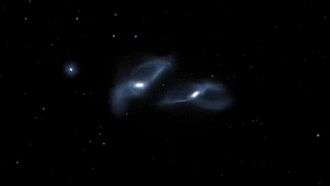
Astronomical radiation mathematics is the laboratory mathematics such as simulations that are generated to try to understand the observations of radiation astronomy.
| |
Subject classification: this is a mathematics resource . |
For some plasma sources, "an exponential spectrum corresponding to a thermal bremsstrahlung source [may fit]":
N(E)dE = E0-1 * exp-E/kTdE.
dN/dE = (E0/E) * exp-E/kT, where a least squares fit to the radiated detection data yields a kT.[145]
Observatories
The materials science of observatories involves the use of novel or adaptive materials that allow greater flexibility in the construction and deployment of observatories on, under, and above rocky-object surfaces. The environment near the observatory can also be used to enhance observation.
Orbital astronomy
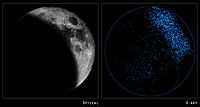
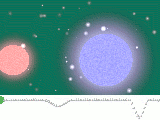
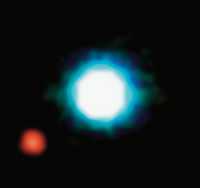
"X-ray emission has been observed from many objects throughout the solar system including the Sun, the Moon, the Earth, Jupiter, and comets."[146] "[S]ome ... emission mechanisms [have been] suggested to explain the observed X-rays"[146].
"Lunar X-rays are thought to be produced by the scattering or fluorescence of solar X-rays from the Moon's surface (Schmitt et al., 1991)."[146]
X-rays from the dark moon, or shadowed portion of the Moon, can be explained by radiation from Earth's geocorona (extended outer atmosphere) through which orbiting spacecraft such as the Chandra X-ray Observatory move.
At the bottom of the visible emission model depicted in the image at left is a visual intensity curve that is often used to deconvolute visible temporal spectra from stellar objects.
A solar binary of the Sun and Jupiter may serve to establish an upper limit for interstellar cometary capture. The basic problem even with a passage through a molecular cloud of some 10 million years is the low relative velocity (~0.5 km s-1) required between the solar system and the cometary medium. Some of the captured bodies may localize in the Oort cloud, while others localize near the Sun or Jupiter.
As stars often occur as binaries or multiple star systems, it is likely that the Sun may have been a member of a binary system or even a multiple star system at some time in the past.
Astrotechnology
"Technology is the making, usage, and knowledge of tools, machines, techniques, crafts, systems or methods of organization in order to solve a problem or perform a specific function. It can also refer to the collection of such tools, machinery, and procedures."[147]
In theoretical radiation astrotechnology, those additional theoretical formulations whether empirical or derived from first principles that are needed to accurately represent astronomical radiation detection signals when laboratory formulations are lacking that pertain to the sources or the telescopes are the technology.
"Emerging technologies are contemporary advances and innovation in various fields of technology. Various converging technologies have emerged in the technological convergence of different systems evolving towards similar goals. Convergence can refer to previously separate technologies such as voice (and telephony features), data (and productivity applications) and video that now share resources and interact with each other, creating new efficiencies. Emerging technologies are those technical innovations which represent progressive developments within a field for competitive advantage;[148] converging technologies represent previously distinct fields which are in some way moving towards stronger inter-connection and similar goals."[149]
Motion calibrators
"POA CALFOS is the improved Post Operational Archive version of the Faint Object Spectrograph (FOS) calibration pipeline ... The current version corrects for image motion problems that have led to significant wavelength scale uncertainties in the FOS data archive. The improvements in the calibration enhance the scientific value of the data in the FOS archive, making it a more homogeneous and reliable resource."[150]
"Although ephemeris time was defined in principle by the orbital motion of the Earth around the Sun,[151] it was usually measured in practice by the orbital motion of the Moon around the Earth.[152] These measurements can be considered as secondary realizations (in a metrological sense) of the primary definition of ET in terms of the solar motion, after a calibration of the mean motion of the Moon with respect to the mean motion of the Sun.[153]"[154]
"Reasons for the use of lunar measurements were practically based: the Moon moves against the background of stars about 13 times as fast as the Sun's corresponding rate of motion, and the accuracy of time determinations from lunar measurements is correspondingly greater."[154]
"When ephemeris time was first adopted, time scales were still based on astronomical observation, as they always had been. The accuracy was limited by the accuracy of optical observation, and corrections of clocks and time signals were published in arrear."[154]
Detectors
Semiconductors have been used extensively to create radiation detectors for ionizing radiation. "The materials in these [infrared detectors] are semiconductors with narrow band gaps."[155] A semiconductor detector for radio waves has been described since the 1890s but has only recently been used in radio and submillimeter radiation detectors.[156]
Research
Hypothesis:
- More metatheory may be needed.
Control groups

The findings demonstrate a statistically systematic change from the status quo or the control group.
“In the design of experiments, treatments [or special properties or characteristics] are applied to [or observed in] experimental units in the treatment group(s).[157] In comparative experiments, members of the complementary group, the control group, receive either no treatment or a standard treatment.[158]"[159]
Proof of concept
Def. a “short and/or incomplete realization of a certain method or idea to demonstrate its feasibility"[160] is called a proof of concept.
Def. evidence that demonstrates that a concept is possible is called proof of concept.
The proof-of-concept structure consists of
- background,
- procedures,
- findings, and
- interpretation.[161]
See also
References
- ↑ Roman Tomaschitz (March 2007). "Superluminal cascade spectra of TeV [gamma-ray sources"]. Annals of Physics 322 (3): 677-700. doi:10.1016/j.aop.2006.11.005. http://wallpaintings.at/geminga/superluminal_cascade_spectra_TeV_gamma-ray_sources.pdf. Retrieved 2011-11-24.
- ↑ "bremsstrahlung, In: Wiktionary". San Francisco, California: Wikimedia Foundation, Inc. December 26, 2010. Retrieved 2012-12-21.
- ↑ "synchrotron radiation, In: Wiktionary". San Francisco, California: Wikimedia Foundation, Inc. November 10, 2012. Retrieved 2012-12-21.
- ↑ "Cerenkov radiation, In: Wiktionary". San Francisco, California: Wikimedia Foundation, Inc. November 10, 2012. Retrieved 2012-12-21.
- 1 2 "power law, In: Wiktionary". San Francisco, California: Wikimedia Foundation, Inc. November 10, 2012. Retrieved 2012-12-21.
- ↑ "background radiation, In: Wiktionary". San Francisco, California: Wikimedia Foundation, Inc. August 28, 2012. Retrieved 2012-12-21.
- ↑ Guido Alpa (1994). "General Principles of Law". Annual Survey of International & Comparative Law 1: 1. http://heinonlinebackup.com/hol-cgi-bin/get_pdf.cgi?handle=hein.journals/ansurintcl1§ion=4. Retrieved 2012-04-29.
- 1 2 "Principle, In: Wikipedia". San Francisco, California: Wikimedia Foundation, Inc. March 24, 2013. Retrieved 2013-04-28.
- ↑ "blackbody, In: Wiktionary". San Francisco, California: Wikimedia Foundation, Inc. December 14, 2012. Retrieved 2013-04-28.
- ↑ "graybody, In: Wiktionary". San Francisco, California: Wikimedia Foundation, Inc. December 14, 2012. Retrieved 2013-04-28.
- ↑ Max Planck, M. Masius (transl.) (1914). The Theory of Heat Radiation (2nd ed.). P. Blakiston's Son & Co. http://ia600201.us.archive.org/16/items/theheatradiation00planrich/theheatradiation00planrich.pdf.
- ↑ Gerald R. Sargent (2008). The use of thermography in clinical Thoracolumbar disease in Dachshunds. Department of Clinical Sciences, Kansas State University. pp. 795.47 kB. http://krex.k-state.edu/dspace/bitstream/2097/1059/1/GeraldSargent2008.pdf. Retrieved 2012-03-03.
- ↑ "emissivity, In: Wiktionary". San Francisco, California: Wikimedia Foundation, Inc. March 16, 2008. Retrieved 2013-04-28.
- 1 2 3 4 5 6 7 "Emissivity, In: Wikipedia". San Francisco, California: Wikimedia Foundation, Inc. March 13, 2013. Retrieved 2013-04-28.
- ↑ "entity, In: Wiktionary". San Francisco, California: Wikimedia Foundation, Inc. February 9, 2013. Retrieved 2013-04-28.
- ↑ Jörg R. Hörandel, N.N. Kalmykov, A.V. Timokhin (October 2006). "The end of the galactic cosmic-ray energy spectrum — a phenomenological view". Journal of Physics: Conference Series 47 (1): 132-41. doi:10.1088/1742-6596/47/1/017. http://arxiv.org/pdf/astro-ph/0508015. Retrieved 2011-12-09.
- ↑ A. Finoguenov, M.G. Watson, M. Tanaka, C.Simpson, M. Cirasuolo, J.S. Dunlop, J.A. Peacock, D. Farrah, M. Akiyama, Y. Ueda, V. Smolčič, G. Stewart, S. Rawlings, C.vanBreukelen, O. Almaini, L.Clewley, D.G. Bonfield, M.J. Jarvis, J.M. Barr, S. Foucaud, R.J. McLure, K. Sekiguchi, E. Egami (April 2010). "X-ray groups and clusters of galaxies in the Subaru-XMM Deep Field". Monthly Notices of the Royal Astronomical Society 403 (4): 2063-76. doi:10.1111/j.1365-2966.2010.16256.x. http://arxiv.org/pdf/0912.0039. Retrieved 2011-12-09.
- ↑ "Introduction to neutron stars". Retrieved 2007-11-11.
- 1 2 "Neutron star, In: Wikipedia". San Francisco, California: Wikimedia Foundation, Inc. April 28, 2013. Retrieved 2013-04-28.
- ↑ "jet, In: Wiktionary". San Francisco, California: Wikimedia Foundation, Inc. April 1, 2013. Retrieved 2013-04-28.
- ↑ "relativistic, In: Wiktionary". San Francisco, California: Wikimedia Foundation, Inc. August 29, 2012. Retrieved 2013-04-28.
- ↑ Ann E. Wehrle, Norbert Zacharias, Kenneth Johnston, David Boboltz, Alan L. Fey, Ralph Gaume, Roopesh Ojha, David L. Meier, David W. Murphy, Dayton L. Jones, Stephen C. Unwin, B. Glenn Piner (February 11, 2009). What is the structure of Relativistic Jets in AGN on Scales of Light Days? In: Galaxies Across Cosmic Time. http://www.nrao.edu/A2010/whitepapers/rac/Wehrle_AGN_jets_GCT.pdf. Retrieved 2013-04-28.
- 1 2 3 4 5 John Biretta (January 6, 1999). "Hubble Detects Faster-Than-Light Motion in Galaxy M87". Baltimore. Maryland USA: Space Telecsope Science Institute. Retrieved 2013-04-28.
- ↑ Yale University - Office of Public Affairs (2006, June 20). Evidence for Ultra-Energetic Particles in Jet from Black Hole (http://web.archive.org/web/20080513034113/http://www.yale.edu/opa/newsr/06-06-20-01.all.html)
- ↑ Meier, L. M. (2003). The Theory and Simulation of Relativistic Jet Formation: Towards a Unified Model For Micro- and Macroquasars, 2003, New Astron. Rev. , 47, 667. (http://arxiv.org/abs/astro-ph/0312048)
- ↑ Semenov, V.S., Dyadechkin, S.A. and Punsly (2004, August 13). Simulations of Jets Driven by Black Hole Rotation. Science, 305, 978-980. (http://www.sciencemag.org/cgi/content/abstract/sci;305/5686/978?maxtoshow=&HITS=10&hits=10&RESULTFORMAT=&fulltext=relativistic+jet&searchid=1&FIRSTINDEX=10&resourcetype=HWCIT)
- ↑ Georganopoulos, M.; Kazanas, D.; Perlman, E.; Stecker, F. (2005) Bulk Comptonization of the Cosmic Microwave Background by Extragalactic Jets as a Probe of their Matter Content, The Astrophysical Journal , 625, 656. (http://arxiv.org/abs/astro-ph/0502201)
- ↑ "Polar jet, In: Wikipedia". San Francisco, California: Wikimedia Foundation, Inc. February 24, 2013. Retrieved 2013-04-28.
- ↑ Martin, Christopher; Seibert, M; Neill, JD; Schiminovich, D; Forster, K; Rich, RM; Welsh, BY; Madore, BF et al. (August 17, 2007). "A turbulent wake as a tracer of 30,000 years of Mira's mass loss history". Nature 448 (7155): 780–783. doi:10.1038/nature06003. PMID 17700694.
- ↑ Minkel, JR."Shooting Bullet Star Leaves Vast Ultraviolet Wake", "The Scientific American", August 15, 2007 Accessed August 21, 2007.
- ↑ Christopher Wareing; Zijlstra, A. A.; O'Brien, T. J.; Seibert, M. (November 6, 2007). "It's a wonderful tail: the mass-loss history of Mira". Astrophysical Journal Letters 670 (2): L125–L129. doi:10.1086/524407. http://www.iop.org/EJ/article/1538-4357/670/2/L125/22252.html.
- ↑ W. Clavin (August 15, 2007). "GALEX finds link between big and small stellar blasts". California Institute of Technology. Archived from the original on 2007-08-27. Retrieved 2007-08-16.
- ↑ Christopher Wareing (December 13, 2008). "Wonderful Mira". Philosophical Transactions of the Royal Society A 366 (1884): 4429–40. doi:10.1098/rsta.2008.0167. PMID 18812301.
- 1 2 3 4 5 6 C. Martin and M. Seibert( (August 15, 2007). "Anatomy of a Shooting Star". Jet Propulsion Laboratory, Pasadena, California, USA: NASA/JPL-Caltech. Retrieved 2012-12-21.
- ↑ M. Karovska et al. (April 28, 2005). "More Images of Mira". NASA/CXC/SAO/M. Karovska et al. Retrieved 2012-12-22.
- ↑ "First Planet-Forming Disk Found in the Environment of a Dying Star." Accessed 1/10/07. http://www.keckobservatory.org/article.php?id=99
- 1 2 "Mira B, In: Wikipedia". San Francisco, California: Wikimedia Foundation, Inc. March 29, 2012. Retrieved 2012-12-22.
- ↑ Jennifer L. Sokoloski, Lars Bildsten (November 2010). "Evidence for the White Dwarf Nature of Mira B". The Astrophysical Journal 723 (2): 1188-94. doi:10.1088/0004-637X/723/2/1188.
- ↑ Adelman, Saul J. (July 8–13, 2004). The Physical Properties of normal A stars. Poprad, Slovakia: Cambridge University Press. pp. 1–11. Bibcode: 2004IAUS..224....1A.
- ↑ Liebert, J.; Young, P. A.; Arnett, D.; Holberg, J. B.; Williams, K. A. (2005). "The Age and Progenitor Mass of Sirius B". The Astrophysical Journal 630 (1): L69–L72. doi:10.1086/462419.
- ↑ Castelaz, Michael W.; Luttermoser, Donald G. (1997). "Spectroscopy of Mira Variables at Different Phases.". The Astronomical Journal 114: 1584–1591. doi:10.1086/118589.
- ↑ H. C. Woodruff, M. Eberhardt; Driebe, T.; Hofmann, K.-H.; Ohnaka, K.; Richichi, A.; Schert, D.; Schöller, M.; Scholz, M.; Weigelt, G.; Wittkowski, M.; Wood, P. R. (2004). "Interferometric observations of the Mira star o Ceti with the VLTI/VINCI instrument in the near-infrared". Astronomy & Astrophysics 421 (2): 703–714. doi:10.1051/0004-6361:20035826. http://www.eso.org/~mwittkow/publications/conferences/SPIECWo5491199.pdf. Retrieved 2007-12-07.
- ↑ J. J. Bochanski and E. M. Sion (May 2001). "The Mystery Companion of Mira Uncovered". Bulletin of the American Astronomical Society 33: 805.
- ↑ Measurements of the frequency of starspots on red giant stars
- ↑ orange sphere of the sun
- ↑ "Red giant, In: Wikipedia". San Francisco, California: Wikimedia Foundation, Inc. December 15, 2012. Retrieved 2012-12-22.
- ↑ "Megacryometeor, In: Wikipedia". San Francisco, California: Wikimedia Foundation, Inc. October 7, 2012. Retrieved 2012-10-13.
- ↑ Fred Lawrence Whipple, G. Turner, J. A. M. McDonnell, M. K. Wallis (1987-09-30). "A Review of Cometary Sciences". Philosophical Transactions of the Royal Society A (Royal Society Publishing) 323 (1572): 339–347 [341]. doi:10.1098/rsta.1987.0090. http://rsta.royalsocietypublishing.org/content/323/1572/339.short.
- ↑ Alessandro Morbidelli (2006). "Origin and dynamical evolution of comets and their reservoirs of water ammonia and methane.". arXiv:astro-ph/0512256.
- ↑ "Kuiper Belt & Oort Cloud". NASA Solar System Exploration web site. NASA. Retrieved 2011-08-08.
- ↑ "Oort cloud, In: Wikipedia". San Francisco, California: Wikimedia Foundation, Inc. December 18, 2012. Retrieved 2012-12-25.
- ↑ C. W. Bert; W. S. Hyler (December 10, 1962). Design Considerations in Selecting Materials for Large Solid-Propellant Rocket-Motor Cases. Columbus Ohio: Battelle Memorial Institute, Defense Metals Information Center. pp. 76. http://www.dtic.mil/cgi-bin/GetTRDoc?AD=AD0294695&Location=U2&doc=GetTRDoc.pdf. Retrieved 2011-12-08.
- ↑ Dania Esposito, Cecilia Faraloni, Floriana Fasolo, Andrea Margonelli, Giuseppe Torzillo, Alba Zanini and Maria Teresa Giardi (2006). Maria Teresa Giardi and Elena V. Piletska. ed. Biodevices for Space Research, In: Biotechnological Applications of Photosynthetic Proteins: Biochips, Biosensors, and Biodevices. Landes Bioscience. pp. 198-208. doi:10.1007/978-0-387-36672-2_17. http://www.springerlink.com/content/j36218165k7hqv3t/fulltext.pdf. Retrieved 2011-12-08.
- ↑ http://www.lifeslittlemysteries.com/2984-voyager-spacecraft-solar-system.html
- ↑ "Voyager 1, In: Wikipedia". San Francisco, California: Wikimedia Foundation, Inc. December 4, 2012. Retrieved 2012-12-05.
- 1 2 3 Fargion D, Khlopov M, Konoplich R, De Sanctis Lucentini PG, De Santis M, Mele B (March 2003). "Ultra High Energy Particle Astronomy, Neutrino Masses and Tau Airshowers". Recent Res Dev Astrophys 1 (3): 395-454. http://arxiv.org/pdf/astro-ph/0303233.
- 1 2 D. B. Wilson and M. J. Rees (October 1978). "Induced Compton scattering in pulsar winds". Monthly Notices of the Royal Astronomical Society 185 (10): 297-304.
- ↑ G. Weidenspointner, G.K. Skinner, P. Jean, J. Knödlseder, P. von Ballmoos, R. Diehl, A. Strong, B. Cordier, S. Schanne, C. Winkler (October 2008). "Positron astronomy with SPI/INTEGRAL". New Astronomy Reviews 52 (7-10): 454-6. doi:10.1016/j.newar.2008.06.019. http://www.sciencedirect.com/science/article/pii/S1387647308001164. Retrieved 2011-11-25.
- 1 2 R Penrose (2004). The Road to Reality: A Complete Guide to the Laws of the Universe. Vintage Books. pp. 410–1. ISBN 9780679776314.
- 1 2 "Speed of light, In: Wikipedia". San Francisco, California: Wikimedia Foundation, Inc. December 10, 2012. Retrieved 2012-12-24.
- ↑ Evenson, KM; et al. (1972). "Speed of Light from Direct Frequency and Wavelength Measurements of the Methane-Stabilized Laser". Physical Review Letters 29 (19): 1346–49. doi:10.1103/PhysRevLett.29.1346.
- ↑ Austin Chambers (2004). Modern Vacuum Physics. Boca Raton: CRC Press. ISBN 0-8493-2438-6. OCLC 55000526.
- 1 2 3 "Vacuum, In: Wikipedia". San Francisco, California: Wikimedia Foundation, Inc. December 10. 2012. Retrieved 2012-12-24.
- ↑ Werner S. Weiglhofer (2003). "§ 4.1 The classical vacuum as reference medium". In Werner S. Weiglhofer and Akhlesh Lakhtakia, eds. Introduction to complex mediums for optics and electromagnetics. SPIE Press. pp. 28, 34. ISBN 9780819449474. http://books.google.com/?id=QtIP_Lr3gngC&pg=PA34.
- ↑ Tom G. MacKay (2008). "Electromagnetic Fields in Linear Bianisotropic Mediums". In Emil Wolf. Progress in Optics, Volume 51. Elsevier. p. 143. ISBN 9780444520388. http://books.google.com/books?id=lCm9Q18P8cMC&pg=PA143.
- ↑ Leonard Susskind (2006). The cosmic landscape: string theory and the illusion of intelligent design. Little, Brown and Co. pp. 60 ff. ISBN 0316013331. http://books.google.com/books?id=RIW9E1sOyxUC&pg=PP60.
- 1 2 Marcel Urban, François Couchot, Xavier Sarazin, Arache Djannati-Atai (March 2013). "The quantum vacuum as the origin of the speed of light". The European Physical Journal D 67: 58. doi:10.1140/epjd/e2013-30578-7. http://link.springer.com/article/10.1140/epjd/e2013-30578-7. Retrieved 2013-03-28.
- ↑ Eoin O'Carroll (March 25, 2013). "Scientists examine nothing, find something". The Christian Science Monitor. Retrieved 2013-03-28.
- ↑ Gerd Leuchs, Luis L. Sánchez-Soto (March 2013). "A sum rule for charged elementary particles". The European Physical Journal D 67: 57. doi:10.1140/epjd/e2013-30577-8. http://link.springer.com/article/10.1140/epjd/e2013-30577-8. Retrieved 2013-03-28.
- ↑ "Electron beam furnace, In: Wikipedia". San Francisco, California: Wikimedia Foundation, Inc. April 14, 2011. Retrieved 2012-12-24.
- 1 2 Steve Cole, Jia-Rui C. Cook, and Alan Buis (December 2011). "NASA's Voyager Hits New Region at Solar System Edge". Washington, DC: NASA. Retrieved 2012-02-09.
- ↑ Philip B. Gove, ed (1963). Webster's Seventh New Collegiate Dictionary. Springfield, Massachusetts: G. & C. Merriam Company. pp. 1221.
- ↑ "Decay and Half Life". Retrieved 2009-12-14.
- 1 2 "Radioactive decay, In: Wikipedia". San Francisco, California: Wikimedia Foundation, Inc. December 24, 2012. Retrieved 2012-12-25.
- ↑ Merrill, McElhinny & McFadden 1996, Chapter 5
- ↑ Tony Phillips (December 29, 2003). "Earth's Inconstant Magnetic Field". Science@Nasa. Retrieved December 27, 2009.
- ↑ "Earth's magnetic field, In: Wikipedia". San Francisco, California: Wikimedia Foundation, Inc. December 21, 2012. Retrieved 2012-12-25.
- 1 2 3 4 5 Riccardo Giacconi, Daniela Calzetti, Mario Livio, Piero Madau, Space Telescope Science Institute (U.S.) - Extragalactic background radiation: a meeting in honor of Riccardo Giacconi : proceedings of the Extragalactic Background Radiation Meeting, Baltimore, 1993 May 18-20, Volume 1993 - Page 137 (Google Books accessed October 2010)
- 1 2 "Diffuse Infrared Background Experiment, In: Wikipedia". San Francisco, California: Wikimedia Foundation, Inc. December 4, 2012. Retrieved 2012-12-24.
- 1 2 "Cosmic Background Explorer, In: Wikipedia". San Francisco, California: Wikimedia Foundation, Inc. November 26, 2012. Retrieved 2012-12-24.
- ↑ T. J. Sodroski, C. Bennett, N. Boggess, E. Dwek, B. A. Franz, M. G. Hauser, T. Kelsall, S. H. Moseley, N. Odegard, R. F. Silverberg, and J. L. Weiland (1994). "Large-Scale Characteristics of Interstellar Dust from COBE DIRBE Observations". The Astrophysical Journal 428 (2): 638–46. doi:10.1086/174274.
- ↑ Hauser M. G., Dwek E., 2001, Annual Review of Astronomy and Astrophysics, 39, 249
- 1 2 "Diffuse extragalactic background radiation, In: Wikipedia". San Francisco, California: Wikimedia Foundation, Inc. February 15, 2012. Retrieved 2012-12-24.
- 1 2 3 "Extragalactic background light, In: Wikipedia". San Francisco, California: Wikimedia Foundation, Inc. December 8, 2012. Retrieved 2012-12-24.
- ↑ Aharonian F. A., Very high energy cosmic gamma radiation: a crucial window on the extreme Universe, River Edge, NJ: World Scientific Publishing, 2004
- ↑ Domínguez et al. 2011, MNRAS, 410, 2556
- ↑ Primack J. R., Bullock J. S., Somerville R. S., MacMinn D., 1999, APh, 11, 93
- ↑ Somerville R. S., Gilmore R. C., Primack J. R., Domínguez A., 2012, arXiv:1104.0669
- ↑ Gilmore R. C., Somerville R. S., Primack J. R., Domínguez A., 2012, arXiv:1104.0671
- ↑ Malkan M. A., Stecker F. W., 1998, ApJ, 496, 13
- ↑ Stecker F. W., Malkan M. A., Scully S. T., 2006, ApJ, 648, 774
- ↑ Franceschini A., Rodighiero G., Vaccari M., 2008, A&A, 487, 837
- ↑ Kneiske T. M., Mannheim K., Hartmann D. H., 2002, A&A, 386, 1
- ↑ Finke J. D., Razzaque S., Dermer C. D., 2010, ApJ, 712, 238
- ↑ Kneiske T.~M., Dole H., 2010, A&A, 515, A19
- ↑ Domínguez et al. 2011, MNRAS, 410, 2556
- 1 2 3 4 Morrison P (1967). "Extrasolar X-ray Sources". Ann Rev Astron Astrophys. 5 (1): 325–50. doi:10.1146/annurev.aa.05.090167.001545.
- ↑ Kupperian JE Jr, Friedman H (1958). "Experiment research US progr. for IGY to 1.7.58". IGY Rocket Report Ser. (1): 201.
- 1 2 "Astrophysical X-ray source, In: Wikipedia". San Francisco, California: Wikimedia Foundation, Inc. November 9, 2012. Retrieved 2012-12-24.
- ↑ Signature Of Antimatter Detected In Lightning - Science News
- 1 2 3 "Lightning, In: Wikipedia". San Francisco, California: Wikimedia Foundation, Inc. December 20, 2012. Retrieved 2012-12-24.
- ↑ U.S. Inan, S.C. Reising, G.J. Fishman, and J.M. Horack. On the association of terrestrial gamma-ray bursts with lightning and implications for sprites. Geophysical Research Letters, 23(9):1017-20, May 1996. As quoted by elf.gi.alaska.edu Retrieved 2007-03-06.
- ↑ http://news.nationalgeographic.com/news/2011/01/110111-thunderstorms-antimatter-beams-fermi-radiation-science-space/
- 1 2 K. J. Frost and B. R. Dennis (May 1, 1971). "Evidence from Hard X-Rays for Two-Stage Particle Acceleration in a Solar Flare". The Astrophysical Journal 165 (5): 655. doi:10.1086/150932.
- ↑ François Roddier, ed (1999). Adaptive Optics in Astronomy. Cambridge, United Kingdom: Cambridge University Press. pp. 411. ISBN 0 521 55375 X. http://catdir.loc.gov/catdir/samples/cam031/00500597.pdf. Retrieved 2012-02-15.
- ↑ "File:Mira the star-by Nasa alt crop.jpg". Wikimedia Commons (San Francisco, California: Wikimedia Foundation, Inc). April 21, 2012. http://commons.wikimedia.org/wiki/File:Mira_the_star-by_Nasa_alt_crop.jpg. Retrieved 2012-07-20.
- ↑ "Color index, In: Wikipedia". San Francisco, California: Wikimedia Foundation, Inc. November 18, 2012. Retrieved 2012-11-20.
- ↑ H. L. Shipman (April 1977). "Masses, radii, and model atmospheres for cool white-dwarf stars". The Astrophysical Journal 213 (4): 138-44. doi:10.1086/155138.
- ↑ Karen Boggs (December 22, 2011). "PIA14913: Orange and Blue Hazes". Pasadena, California, USA: NASA, JPL, California Institute of Technology. Retrieved 2012-11-26.
- ↑ Munsell, Kirk; Smith, Harman; Harvey, Samantha (November 13, 2007). "Neptune overview". Solar System Exploration. NASA. Retrieved February 20, 2008.
- ↑ "Neptune, In: Wikipedia". San Francisco, California: Wikimedia Foundation, Inc. June 1, 2012. Retrieved 2012-06-08.
- ↑ E. B. Newell (August 1973). "The Evolutionary Status of the Blue Halo Stars". The Astrophysical Journal Supplement 26 (8): 37-81. doi:10.1086/190279.
- 1 2 Carle’ M. Pieters. Mare basalt types on the front side of the moon - A summary of spectral reflectance data, In: Lunar and Planetary Science Conference, 9th, Houston, Tex., March 13-17, 1978, Proceedings. 3. New York: Pergamon Press, Inc.. pp. 2825-49. Bibcode: 1978LPSC....9.2825P.
- ↑ D. J. Heather, S. K. Dunkin, P. D. Spudis, D. B. J. Bussey (January 1999). A Multispectral Analysis of the Flamsteed Region of Oceanus Procellarum, In: Workshop on New Views of the Moon 2: Understanding the Moon Through the Integration of Diverse Datasets. Bibcode: 1999nvm..conf...24H.
- ↑ Holli Riebeek (January 3, 2009). "Sediment off the Yucatan Peninsula". NASA. Retrieved 2012-07-22.
- ↑ C. L. Searle (1971). The Astrophysical Journal 168: 327.
- ↑ K. Lind, M. Asplund, P. S. Barklem (August 2009). "Departures from LTE for neutral Li in late-type stars". Astronomy and Astrophysics 503 (2): 541-4. doi:10.1051/0004-6361/200912221.
- ↑ Jeremy R. King, Constantine P. Deliyannis, and Merchant Boesgaard (April 1, 1997). "The 9Be Abundances of α Centauri A and B and the Sun: Implications for Stellar Evolution and Mixing". The Astrophysical Journal 478 (2): 778. http://iopscience.iop.org/0004-637X/478/2/778/pdf/0004-637X_478_2_778.pdf. Retrieved 2012-07-11.
- ↑ M. H. van Kerkwijk, P. A. Charles, T. R. Geballe, D. L. King, G. K. Miley, L. A. Molnar, E. P. J. van den Heuvel, M. van der Kils & J. van Paradlja (February 20, 1992). "Infrared helium emission lines from Cygnus X-3 suggesting a Wolf-Rayet star companion". Nature 355: 703-5. http://dare.uva.nl/document/15325. Retrieved 2012-08-03.
- ↑ M.J. Griffin, P.A.R. Ade, G.S. Orton, E.I. Robson, W.K. Gear, I.G. Nolt, J.V. Radostitz (February-March 1986). "Submillimeter and millimeter observations of Jupiter". Icarus 65 (2-3): 244-56. doi:10.1016/0019-1035(86)90137-5. http://www.sciencedirect.com/science/article/pii/0019103586901375. Retrieved 2012-08-04.
- 1 2 Kuan YJ, Charnley SB, Huang HC, et al. (2003). "Interstellar glycine". The Astrophysical Journal 593 (2): 848–67. doi:10.1086/375637.
- 1 2 Snyder LE, Lovas FJ, Hollis JM, et al. (2005). "A rigorous attempt to verify interstellar glycine". The Astrophysical Journal 619 (2): 914–30. doi:10.1086/426677.
- 1 2 3 4 "Astrochemistry, In: Wikipedia". San Francisco, California: Wikimedia Foundation, Inc. August 27, 2012. Retrieved 2012-08-30.
- ↑ Daniel Rohrlich and Yakir Aharonov (October 2002). "Cherenkov radiation of superluminal particles". Physical Review A 66 (4): 7. doi:10.1103/PhysRevA.66.042102. http://arxiv.org/pdf/quant-ph/0107025v2.pdf. Retrieved 2012-07-28.
- ↑ "astrochemistry, In: Wiktionary". San Francisco, California: Wikimedia Foundation, Inc. 16 June 2013. Retrieved 2015-02-06.
- ↑ see http://www.cfa.harvard.edu/mmw/CO_survey_aitoff.jpg.
- ↑ Space Weather Prediction Center (October 15, 2009). "GLOSSARY OF SOLAR-TERRESTRIAL TERMS". NOAA / Space Weather Prediction Center. Retrieved 2012-04-18.
- ↑ "Coronal loop, In: Wikipedia". San Francisco, California: Wikimedia Foundation, Inc. December 25, 2012. Retrieved 2012-12-25.
- ↑ Yukio Katsukawa and Saku Tsuneta (March 2005). "Magnetic Properties at Footpoints of Hot and Cool Loops". The Astrophysical Journal 621 (1): 498-511. doi:10.1086/427488. http://iopscience.iop.org/0004-637X/621/1/498/pdf/0004-637X_621_1_498.pdf. Retrieved 2011-12-09.
- ↑ "Plasma stability, In: Wikipedia". San Francisco, California: Wikimedia Foundation, Inc. June 27, 2012. Retrieved 2012-11-15.
- 1 2 "Fermilab, In: Wikipedia". San Francisco, California: Wikimedia Foundation, Inc. December 14, 2012. Retrieved 2012-12-23.
- ↑ "MIRA's Field Trips to the Stars Internet Education Program". Monterey Institute for Research in Astronomy. Retrieved August 27, 2007.
- ↑ "Uranus, In: Wikipedia". San Francisco, California: Wikimedia Foundation, Inc. December 18, 2012. Retrieved 2012-12-23.
- 1 2 Jean Baptiste Joseph Delambre (1817). Histoire de l'astronomie ancienne. Paris: Courcier. pp. 639. http://books.google.com/books?id=2lVUjJSxjhQC&source=gbs_selected_pages&cad=3#v=onepage&f=false. Retrieved 2012-01-13.
- 1 2 Immanuel Velikovsky (January 1965). Worlds in Collision. New York: Dell Publishing Co., Inc.. pp. 401. http://books.google.com/books?id=FJst27kSVBgC&pg=PA13&hl=en. Retrieved 2012-01-13.
- ↑ E. F. Weidner (1915). Handbuch der babylonischen Astronomie.
- 1 2 AnonMoos (October 8, 2012). "Image in Vasari painting, In: Wikimedia Commons". San Francisco, California: Wikimedia Foundation, Inc. Retrieved 2012-10-08.
- 1 2 3 4 5 6 A. L. Cortie (December 1900). "Synopsis of Lecture on "The Solar Corona" by the Rev. A.L. Cortie to the Members of the North-Western Branch (Manchester) on 7th November 1900". Journal of the British Astronomical Association 11 (12): 77-8. http://adsabs.harvard.edu/cgi-bin/nph-data_query?bibcode=1900JBAA...11...77C&link_type=ARTICLE&db_key=AST&high=. Retrieved 2011-11-09.
- ↑ "Cosmogony, In: Wikipedia". San Francisco, California: Wikimedia Foundation, Inc. May 31, 2012. Retrieved 2012-06-06.
- ↑ "Chaos (cosmogony), In: Wikipedia". San Francisco, California: Wikimedia Foundation, Inc. December 23, 2012. Retrieved 2012-12-25.
- ↑ Hyginus, Fabulae Preface.
- 1 2 "Aether (mythology), In: Wikipedia". San Francisco, California: Wikimedia Foundation, Inc. November 8, 2012. Retrieved 2012-12-25.
- ↑ "AETHER: Greek protogenos god of upper air & light ; mythology : AETHER". Theoi.com.
- ↑ W.N. Colley and E. Turner, J.A. Tyson (April 24, 1996). "Hubble Space Telescope Completes Sixth Year of Exploration". Princeton University, Princeton, New Jersey, USA: STScl/NASA. Retrieved 2012-12-25.
- ↑ R. M. Thomas (December 1968). "The Detection of High-Energy X-rays from Ara XR-1 and Nor XR-1". Proceedings of the Astronomical Society of Australia 1 (12): 156-6.
- 1 2 3 T. E. Cravens (2000). "X-ray emission from comets and planets". Advances in Space Research 26 (10): 1443-51. doi:0.1016/S0273-1177(00)00100-9. http://www.sciencedirect.com/science/article/pii/S0273117700001009. Retrieved 2012-01-11.
- ↑ "Technology, In: Wikipedia". San Francisco, California: Wikimedia Foundation, Inc. December 6, 2012. Retrieved 2012-12-23.
- ↑ International Congress Innovation and Technology XXI: Strategies and Policies Towards the XXI Century, & Soares, O. D. D. (1997). Innovation and technology: Strategies and policies. Dordrecht: Kluwer Academic.
- ↑ "Emerging technologies, In: Wikipedia". San Francisco, California: Wikimedia Foundation, Inc. December 11, 2012. Retrieved 2012-12-23.
- ↑ "POA CALFOS, In: Wikipedia". San Francisco, California: Wikimedia Foundation, Inc. July 22 2012. Retrieved 2012-12-23.
- ↑ "On the System of Astronomical Constants", Astronomical Journal, vol.53(6) (1948), issue #1170, pp 169–179
- ↑ William Markowitz, R G Hall, S Edelson (1955), "Ephemeris time from photographic positions of the moon", Astronomical Journal, vol. 60 (1955), p.171; William Markowitz (1959), "Variations in the Rotation of the Earth, Results Obtained with the Dual-Rate Moon Camera and Photograhic Zenith Tubes", Astronomical Journal, vol.64 (1959), pp. 106–113.; also William Markowitz, R G Hall, L Essen, J V L Parry (1958), "Frequency of cesium in terms of ephemeris time", Physical Review Letters, vol.1 (1958), 105–107.
- ↑ B Guinot and P K Seidelmann (1988), "Time scales – Their history, definition and interpretation", Astronomy and Astrophysics, vol. 194 (nos. 1–2) (April 1988), pp.304–308.
- 1 2 3 "Ephemeris time, In: Wikipedia". San Francisco, California: Wikimedia Foundation, Inc. November 1, 2012. Retrieved 2012-12-23.
- ↑ "Infrared detector, In: Wikipedia". San Francisco, California: Wikimedia Foundation, Inc. April 8, 2012. Retrieved 2012-06-19.
- ↑ D.T. Emerson (December 1997). "The Work of Jagadis Chandra Bose: 100 Years of MM-Wave Research". IEEE Transactions on Microwave Theory and Techniques 45 (12): 2267-73. http://www.tuks.nl/pdf/Reference_Material/j.c._bose__60_ghz_in_the_1890s.pdf. Retrieved 2012-12-25.
- ↑ Klaus Hinkelmann, Oscar Kempthorne (2008). Design and Analysis of Experiments, Volume I: Introduction to Experimental Design (2nd ed.). Wiley. ISBN 978-0-471-72756-9. http://books.google.com/?id=T3wWj2kVYZgC&printsec=frontcover.
- ↑ R. A. Bailey (2008). Design of comparative experiments. Cambridge University Press. ISBN 978-0-521-68357-9. http://www.cambridge.org/uk/catalogue/catalogue.asp?isbn=9780521683579.
- ↑ "Treatment and control groups, In: Wikipedia". San Francisco, California: Wikimedia Foundation, Inc. May 18, 2012. Retrieved 2012-05-31.
- ↑ "proof of concept, In: Wiktionary". San Francisco, California: Wikimedia Foundation, Inc. November 10, 2012. Retrieved 2013-01-13.
- ↑ Ginger Lehrman and Ian B Hogue, Sarah Palmer, Cheryl Jennings, Celsa A Spina, Ann Wiegand, Alan L Landay, Robert W Coombs, Douglas D Richman, John W Mellors, John M Coffin, Ronald J Bosch, David M Margolis (August 13, 2005). "Depletion of latent HIV-1 infection in vivo: a proof-of-concept study". Lancet 366 (9485): 549-55. doi:10.1016/S0140-6736(05)67098-5. http://www.ncbi.nlm.nih.gov/pmc/articles/PMC1894952/. Retrieved 2012-05-09.
Further reading
- Roman Tomaschitz (March 2007). "Superluminal cascade spectra of TeV [gamma-ray sources"]. Annals of Physics 322 (3): 677-700. doi:10.1016/j.aop.2006.11.005. http://wallpaintings.at/geminga/superluminal_cascade_spectra_TeV_gamma-ray_sources.pdf. Retrieved 2011-11-24.
External links
- African Journals Online
- Bing Advanced search
- Google Books
- Google scholar Advanced Scholar Search
- International Astronomical Union
- JSTOR
- Lycos search
- NASA/IPAC Extragalactic Database - NED
- NASA's National Space Science Data Center.
- NCBI All Databases Search
- PubChem Public Chemical Database
- Questia - The Online Library of Books and Journals
- SAGE journals online
- The SAO/NASA Astrophysics Data System
- Scirus for scientific information only advanced search
- SDSS Quick Look tool: SkyServer
- SIMBAD Astronomical Database
- Spacecraft Query at NASA.
- SpringerLink
- Taylor & Francis Online
- Wiley Online Library Advanced Search
- Yahoo Advanced Web Search
| ||||||||||||||||||||||||||||||||
| |||||||||||||||||||||||||||||||||||||||||
| |||||||||||||||||||||||||||||
![]() This is a research project at http://en.wikiversity.org
This is a research project at http://en.wikiversity.org
| |
Development status: this resource is experimental in nature. |
| |
Educational level: this is a research resource. |
| |
Resource type: this resource is an article. |
| |
Resource type: this resource contains a lecture or lecture notes. |
| |
Subject classification: this is an astronomy resource. |
